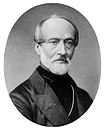1861 Italian general election
| |||||||||||||||||
All 443 seats in the Chamber of Deputies 222 seats needed for a majority | |||||||||||||||||
|---|---|---|---|---|---|---|---|---|---|---|---|---|---|---|---|---|---|
| |||||||||||||||||
 Constituencies used for the elections | |||||||||||||||||
| |||||||||||||||||
General elections were held in Italy on 27 January 1861, with a second round on 3 February.[1] The newly elected Parliament first convened in Turin on 4 March 1861, where, thirteen days later, it declared the unification of the country as the Kingdom of Italy.[2]
The elections were carried out according to the 1848 electoral law of the Kingdom of Sardinia, in which only literate men over the age of 25 and paying a certain level of taxation were allowed to vote.[1] Candidates were elected in single member constituencies, with a second round required in cases when no candidates received over 50% of the vote or the equivalent of one-third of the registered voters in the constituency.[3] The Pope demanded that Catholics did not take part in the elections.[3]
Campaign
[edit]The Historical Right was led by the former Prime Minister of the Kingdom of Sardinia, Camillo Benso, Count of Cavour, a long-time statesman and a leading figure in the movement toward Italian unification.
On the other hand, the bloc of the Historical Left was led by Urbano Rattazzi, a liberal politician who was among the founders of the Italian left-wing parliamentary group.
In opposition to the two main blocs there were a third party known as The Extreme, a far-left coalition, under the leadership of Giuseppe Mazzini, an Italian revolutionary and a key figure of the Unification.
Only 418,696 men of a total population of around 22 million were entitled to vote.[4]
Parties and leaders
[edit]| Party | Ideology | Leader | |
|---|---|---|---|
| Historical Right | Conservatism | Camillo Benso di Cavour | |
| Historical Left | Liberalism | Urbano Rattazzi | |
| Historical Far Left | Radicalism | Giuseppe Mazzini | |
Results
[edit]
Right-wing candidates emerged as the largest bloc in Parliament with around 43% of the 443 seats.[5] They were largely aristocrats representing rentiers from the north of the country, and held moderate political views including loyalty to the crown and low government spending.[6] The right-wing leader Camillo Benso di Cavour was elected as the first Prime Minister in the history of Italy.
| Party | Votes | % | % of seats | |
|---|---|---|---|---|
| Historical Right | 42.5 | |||
| Historical Left | 27.6 | |||
| Historical Far Left | 4.4 | |||
| Others | 25.5 | |||
| Total | 100 | |||
| Total votes | 239,583 | – | ||
| Registered voters/turnout | 418,696 | 57.22 | ||
| Source: Nohlen & Stöver | ||||



